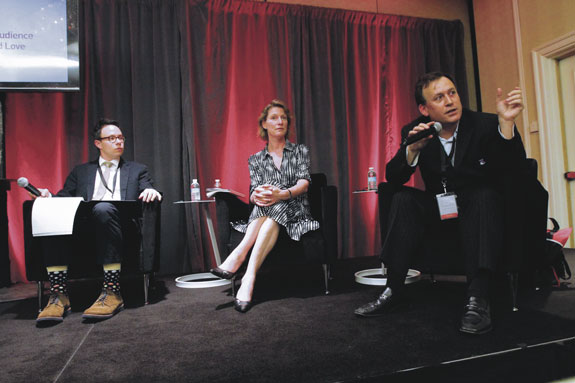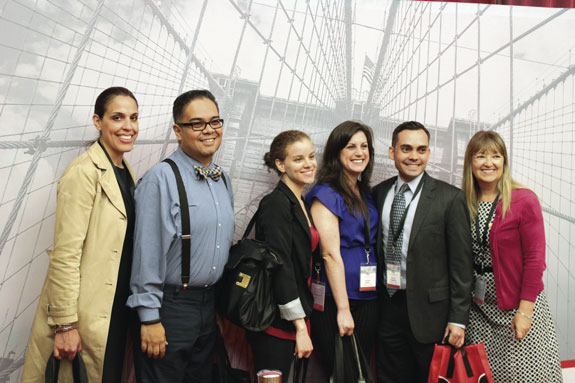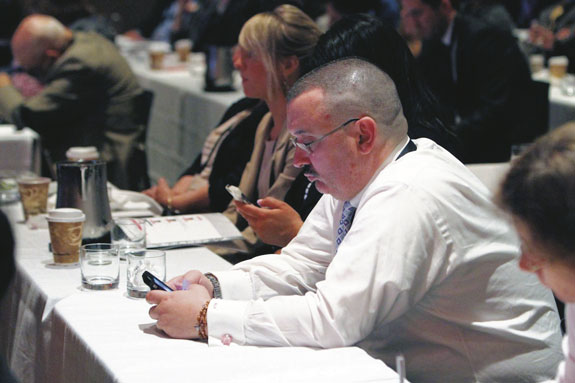#ChurchLearnstoUseNewFormsofSocialCommunication

The Church must establish a presence in the digital world of communications, said the president of the Pontifical Council of Social Communications when he addressed a Brooklyn gathering of church communicators.
“If the Church is not present and does not share the Good News of God’s love for all people in this world, then we risk becoming marginal to the lives of many and are failing our mission to bring the Gospel to the ends of the earth,” Archbishop Claudio Maria Celli told more than 250 people who attended the diocesan celebration of World Communications Day, May 22, at the Marriott at the Brooklyn Bridge.
The event was organized by the DeSales Media Group, the parent company of The Tablet.
Before the archbishop’s keynote address, Bishop Nicholas DiMarzio and Msgr. Kieran Harrington, president of DeSales, presented Archbishop Celli with the group’s St. Francis de Sales Award.
Archbishop Celli was honored for being instrumental in starting Pope Benedict XVI’s Twitter account (@Pontifex), that is now handled by Pope Francis. He also oversaw the creation of the Pope App, which allows followers to receive updates regarding important papal events.
Changing Nature of Technology

Archbishop Celli said that so much has changed in the field of technology in the last decade, and he encourages Church leaders and media organizations to reflect on these changes and to develop appropriate forms of engagement with the target audience.
In what Pope Benedict has called the “digital revolution,” Archbishop Celli said that it’s easy to focus solely on the technological developments themselves, such as smartphones and all modern forms of social media.
“The truth is that the most significant change is not technological but cultural,” he said. “The real challenge is to appreciate how much is changing in the ways people, especially young people, are gathering information, are being educated, are expressing themselves and are forming relationships and communities.”
He echoed Pope Benedict’s words from 2012 in that “new technologies are not only changing the way we communicate but communication itself.”
Moreover, he said he is reluctant to use the term “new media,” since these forms of technology have become the norm around the globe, and increasingly in developing countries.
“To talk of new media is to date oneself and to risk failing to appreciate the ordinariness in the lives of so many,” the archbishop said.
The Church’s goal, Archbishop Celli said, is to embrace this new culture of modern communication, which has become engrained in the daily lives of people everywhere, especially young people.
The Effectiveness of Language

Archbishop Celli also spoke of how language has taken on new forms in regards to the new technologies. He highlighted three issues, with the first being an adjustment to the style of communication.
Archbishop Celli said that the Church must keep up with today’s forms of communications. He challenged Church media organizations to produce engaging content that sparks conversation.
Secondly, he spoke about how the traditional mode of expression was very dependent on text. While words and text are still important, multimedia content – including images, video, music and gestures – can be much more effective in conveying the message of a particular medium.
He said that photos and videos especially garner the most attention on social media websites, and the Church must use these platforms to its advantage.
Finally, Archbishop Celli said that the Church must recognize that some of its vocabulary might be problematic for its contemporaries. The challenge here is to rediscover simple words and metaphors with the goal of capturing the attention of a broader audience.
While the new forms of technology can be effective for the Church in spreading its mission, Archbishop Celli said the Church’s presence in the digital age can only work if “we are authentic witnesses to our faith.”
Rather than focus on how the new forms of technology can be used to evangelize, the religious media instead must concentrate its efforts on how to become an evangelizing presence in the new world that has been brought into being by the new technologies.
He also said that media organizations must refrain from bombarding its audience with information but instead must spark conversation to allow the audience to take an active role in the content. If the audience is given the opportunity to explore an issue further, the archbishop said, the desire for more content keeps them coming back.
“We have to ensure that the digital world can be an environment rich in humanity – a network not of wires but of people,” he said.
The challenge here is not easy, the archbishop said, but it can be achieved by establishing a network that engages debates and invites social media, which would in turn reflect the truth of the Church as a community of communities which is alive both universally and locally.
“Who we are and how we behave will always speak more eloquently than our words,” he said. “Our words, our profession of faith and our expression of a desire to share this faith with others will only speak to others if they come from our hearts. In order to effectively share our faith and our hopes, we must nourish our own faith and relationship with Jesus and allow His grace to change us.”
The archbishop concluded by recognizing the wide-ranging efforts of Catholic media institutions to establish the Church’s digital presence in the world. He said he is convinced that the Church’s efforts in this area will undoubtedly bear fruit.
“By keeping alive the intensity of our communion with Jesus in prayer, the sacraments and service of the poor,” the archbishop said, “we will become credible witnesses to the power of God’s grace and help others find their way to Him.”
Engaging the Public as a Church

During the breakout-session portion of the day, Jesuit Father Matt Malone, editor in chief of America magazine, spoke on “Catholics and Controversy: How the Church can engage and moderate online discussions on matters of faith and public policy.”
Father Malone shared what he called “modest thoughts … about how we can really engage in the public square as a Church in a way that is part of the solution, both from a civil point of view and an ecclesial point of view, rather than as part of the problem.”
The problem of today’s ecclesial discourse – the conversation Catholics have with each other, he explained, is that it does not look “different enough” from the political discourse in secular society.
“There is a way in which we are simply mimicking the larger culture by structuring our conversation in rigid categories of left and right,” he said.
That kind of thinking is acceptable in a political community composed of factions, he said, but not in the Church.
“The Church conceived along secular or political lines is no longer the one Body of Christ,” he said.
In recent years, with the rise of cable TV and the Internet, Father Malone explained that secular media has stopped trying to bring people together to form mass markets. Instead, they pull people apart – highlighting differences in order to form narrow, splinter groups.
“There are ways in which the Catholic press has … mimicked this behavior and so when people look to the Catholic press for something different, for a different take or a different form of analysis … they’re not seeing something different enough,” he said.
While emerging technologies have the capacity to bring people together, he noted that they’re also equally capable of depersonalizing human interactions. Therefore, the challenge is to bring people together and maintain a personal dimension.
He said America magazine has taken steps toward being a more “reconciling presence” in the media by being more conscious of word choices, trying to engage print and online readers in an informed and charitable way, placing a premium on prayer and incorporating a personal dimension into its ministry.
Radiating Joy Online
In an adjoining salon, Mary DeTurris Poust, a Catholic author and blogger, challenged her audience to bring the Good Word to the people of the world through the use of social media in a subtle, guerrilla warfare manner.
“Subtle is not what most posters are going for,” she said.
Many posters believe that the loudest point will come across the best, DeTurris Poust said. However, when posters simply force their message on others, it becomes white noise. Most Internet users have trained themselves to ignore the voices that repeat themselves over and over and stop reading the instant someone starts writing in caps lock.
On her own blog, Not Strictly Spiritual, DeTurris Poust uses a less intense method. She posts on a wide array of topics from how broken sea shells are a metaphor for God’s retainership with His people, to being a woman and deciding to show her natural grey hair, to a guide to Lent. This way, people don’t know what to expect and perhaps come for one of her more fun posts and stay to read her posts on spirituality.
The strategy seems to work. DeTurris Poust gave an example of a reaction from an atheist blogger who responded to her guide to Lent. The blogger acknowledged the values of Lent on her own site as a response to DeTurris Poust’s post. The blogger said Lent is like a new year’s resolution but more practical because it is only for 40 days and would seem to have many benefits.
DeTurris Poust did admit that responses to her writing are not always positive, saying she was even once accused of opening a portal to Satan. Therefore, she has learned to not take all criticism to heart and to not respond or even read every reaction. She encourages her audience to stay in control when visiting the online realm.
“Social media can take as much or as little time as you want,” she said. “It doesn’t have to monopolize your time.”
The Catholic blogger also encourages her audience to not be disheartened. Most of the reactions to her writing is positive because she writes about spirituality, she said. This allows her to find a supportive community online, whose members pray for one another with true concern.
The online world can no longer be ignored because it is where people build their support systems, she said.
“It’s where they share their joys, their sorrows, their beliefs,” DeTurris Poust said. “We have to meet the people where they are at, and this is where they are at.”
People no longer congregate in the parish hall or even in the street corners, she observed; people now spend much of their time socializing online. It is also where they go to uncover truth.
“They are looking, and if we are not there, they will go somewhere else,” she said.
Therefore, DeTurris Poust encourages people of faith to go online and “radiate joy,” just as Pope Francis does, and Pope Benedict did before him. When St. Peter had to go out in the deep to find the people, he had to strap on sandals and go down dusty paths. Today, Catholics can reach souls searching for God by simply turning on the computer.
DeTurris Poust said reaching a person’s heart can be as simple as posting a photo of a beautiful moon, or something else people enjoy looking at, and attaching a Bible quote to it because “a picture is worth … at least 15 words and a hashtag.”
A third session featured a panel on Growing Your Audience with Likes and Love.[hr]
Contributing to this article were Marie Elena Giossi and Antonina Zielinska.

Excellent article; too bad that there is not a way to send this out to other via email.